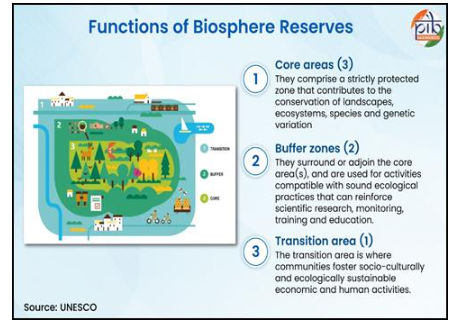Celebrating International Day of Biosphere Reserves
Introduction:
The International Day of Biosphere Reserves (Nov 3) celebrates areas where nature and communities coexist sustainably.
-
- Biosphere Reserves (BRs) act as living laboratories for conservation, sustainable development, and community well-being. India’s celebration highlights its strong commitment to biodiversity protection, eco-restoration, and people–nature harmony.
- The initiative aligns with the UNESCO Man and Biosphere (MAB) Programme, emphasizing science-based, community-led conservation.
What are Biosphere Reserves?
Biosphere Reserves are ecosystem areas identified for biodiversity conservation and sustainable livelihood promotion. Defined as “learning places for sustainable development”, they test interdisciplinary approaches to manage social–ecological interactions.
-
- They include terrestrial, marine, and coastal ecosystems, integrating conservation with sustainable use. BRs are nominated by national governments and remain under national jurisdiction.
- Over 260 million people globally live in BRs, covering 7 million sq. km, roughly equal to Australia’s size.

UNESCO’s Man and Biosphere (MAB) Programme: An international UNESCO initiative recognizing and supporting Biosphere Reserves as models of sustainable human–nature interaction.
Objectives of MAB:
-
-
- Study changes in ecosystems and their impact on humans.
- Promote knowledge-sharing and environmental education.
- Support climate change resilience and biodiversity preservation.
- Encourage innovation combining natural and social sciences for equitable development.
- World Network of Biosphere Reserves (WNBR): A global network promoting cooperation and best practices.
- Governed by MAB International Coordinating Council (MAB-ICC) with 34 Member States.
-
India’s Biosphere Reserves:
-
- Total Reserves: 18 notified BRs, covering 91,425 sq. km.
- UNESCO Recognition: 13 of these are part of the World Network of Biosphere Reserves (WNBR).
- New Addition (2025): Cold Desert Biosphere Reserve (Himachal Pradesh) included in UNESCO list.
- Administered by the Biosphere Reserve Division, MoEFCC under a Centrally Sponsored Scheme (CSS) for Biodiversity Conservation.
-
- The Biosphere Reserve Divisionof the Ministry of Environment, Forest, and Climate Change (MoEFCC) administers a Centrally Sponsored Scheme (CSS) for Biodiversity Conservation, which operates as a sub-scheme under the broader Conservation of Natural Resources and Ecosystems (CNRE)
- The scheme provides financial assistance to states for targeted conservation and development activities, with implementation primarily handled by State Forest Departments.
-
- Funding Pattern:
- 60:40 (Centre:State)
- 90:10 for North-Eastern & Himalayan States.
- Budget Doubling: ₹5 crore (2024–25) → ₹10 crore (2025–26).
- Focus on local community engagement, eco-development, and alternative livelihoods to reduce dependence on core biodiversity zones.
- India ranks 9th globally in forest area and 3rd in annual forest gain (FAO 2025).
- Emphasis on community-led conservation and climate resilience.
- Biosphere Reserves integrate conservation with livelihood generation, supporting eco-tourism, handicrafts, and non-timber forest produce (NTFPs).
- Funding Pattern:
Complementary National Initiatives: Biosphere Reserves work in synergy with India’s flagship conservation programmes:-
| Scheme / Mission | Objective & Contribution |
|---|---|
| Project Tiger (1973) | Revived tiger population; flagship conservation model. |
| Project Elephant | Protects elephant habitats, mitigates human-elephant conflict. |
| Integrated Development of Wildlife Habitats (IDWH) | Financial & technical aid for wildlife conservation. |
| National Biodiversity Action Plan (NBAP) | Regulates access to biological resources under the Biodiversity Act, 2002. |
| Eco-Sensitive Zones (ESZs) | Buffer zones around Protected Areas to act as ecological “shock absorbers.” |
| Green India Mission (GIM) | Restores forest ecosystems, enhances carbon sinks, and supports biodiversity. |
Impact of Conservation Efforts
-
- BRs have strengthened ecosystem balance and biodiversity health.
- Support sustainable livelihoods for forest-dependent populations.
- Improve climate adaptation and forest cover quality.
- India’s inclusion in FAO’s Global Forest Resources Assessment 2025 showcases measurable progress.
- Enhanced community participation and research integration have made India a global leader in biosphere management.
Significance
-
- Demonstrates India’s leadership in balancing ecological integrity and human development.
- Promotes inclusive, science-based conservation involving local communities.
- Strengthens India’s role in achieving SDGs, particularly Goals 13 (Climate Action) and 15 (Life on Land).
- Reinforces national goals of “Viksit Bharat” and “Lifestyle for Environment (LiFE)”.
Conclusion:
India’s celebration of the International Day of Biosphere Reserves reaffirms its enduring commitment to biodiversity protection, sustainable resource use, and community empowerment.
Spread the Word

